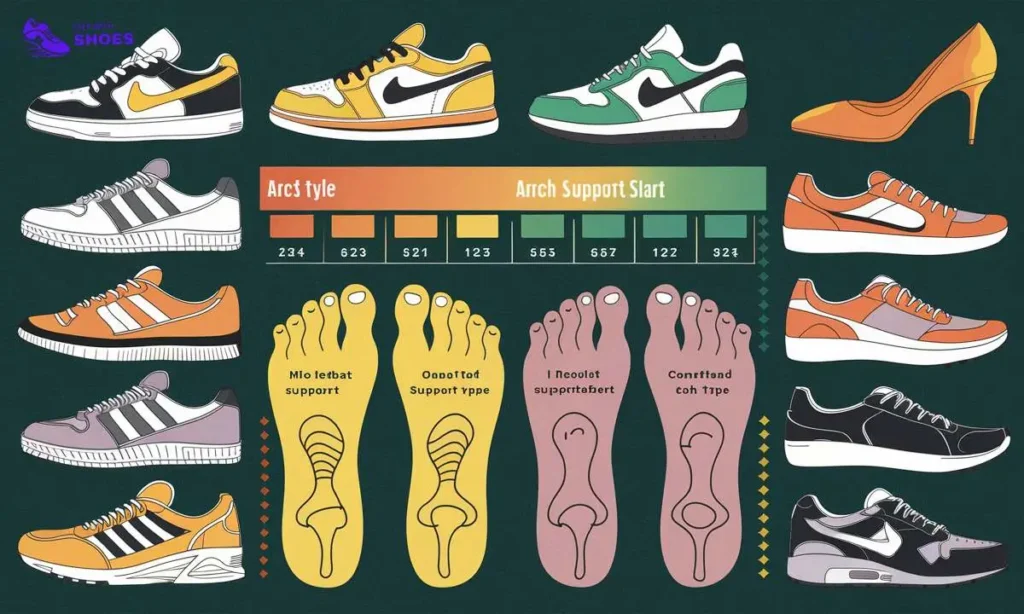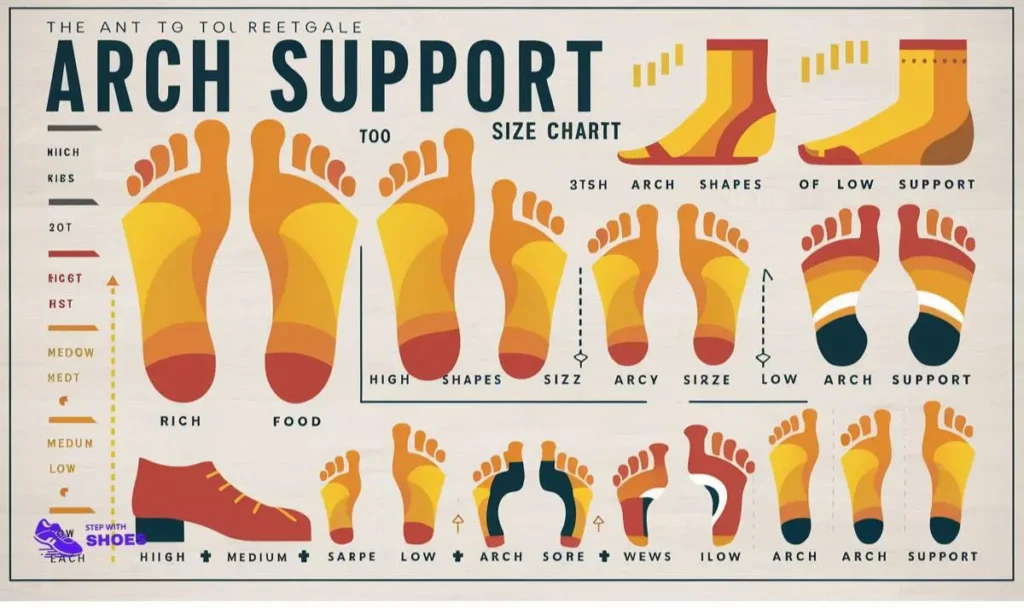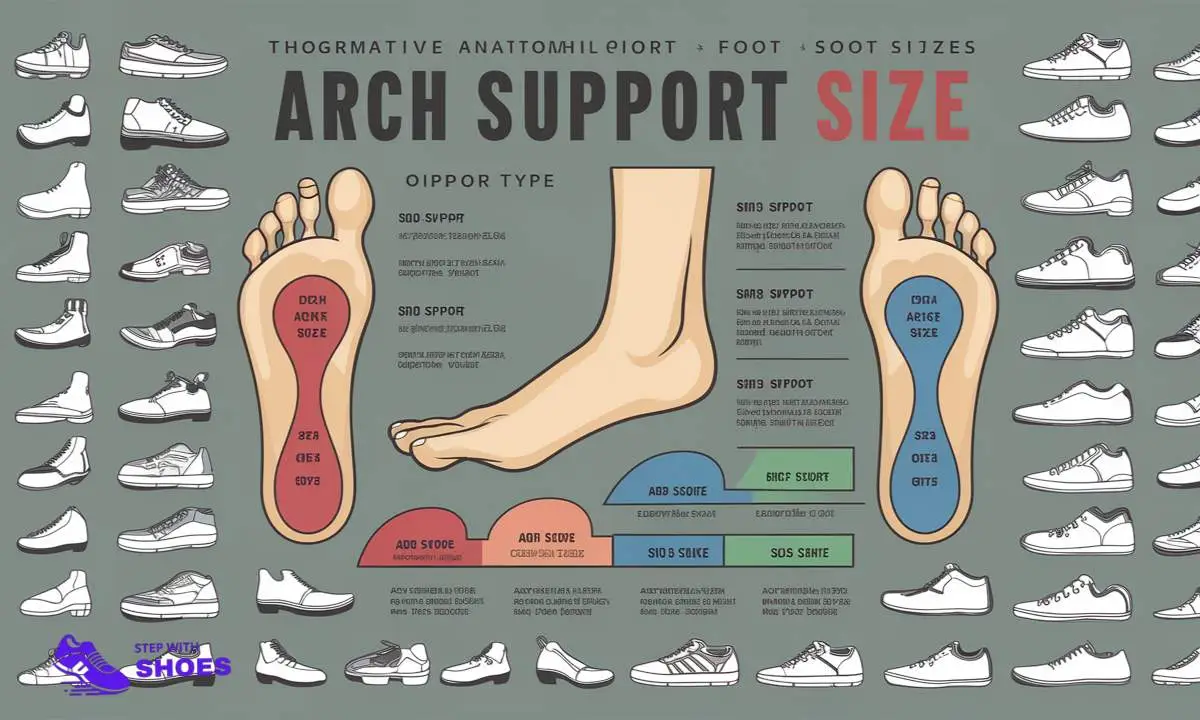Arch support size charts help determine the right fit for insoles and orthotics. Proper sizing ensures comfort and foot health.
Understanding arch support size charts is crucial for selecting the right insoles or orthotics. Proper arch support helps alleviate foot pain, enhances comfort, and prevents injuries. Size charts provide measurements that guide you to the best fit, based on your shoe size and foot arch type.
Using the correct size ensures that your insoles or orthotics offer optimal support and cushioning. This, in turn, improves your overall foot health and well-being. Whether you have flat feet or high arches, referring to a size chart can make all the difference in achieving the perfect fit and support.
Importance Of Arch Support
Understanding the importance of arch support is crucial for maintaining healthy feet. Proper arch support can alleviate pain, prevent injuries, and enhance comfort. Let’s delve into the benefits and common issues related to arch support.
Health Benefits
Proper arch support offers numerous health benefits. It can improve your posture and balance. This leads to reduced stress on your feet and legs.
Here are some key benefits:
- Reduces pain in the feet and legs.
- Prevents foot conditions like plantar fasciitis.
- Enhances overall foot stability.
Arch support also helps distribute body weight evenly. This minimizes pressure points and reduces discomfort.
Common Foot Problems
Without proper arch support, several foot problems may arise. These issues can lead to chronic pain and discomfort.
Here are some common problems:
- Plantar fasciitis
- Flat feet
- Heel spurs
- Bunions
Proper arch support can prevent these conditions. It provides the necessary support for your foot’s natural structure.
To ensure you choose the right arch support, refer to an arch support size chart. This chart helps identify the best fit for your feet.
A size chart can look like this:
| Foot Length (inches) | Arch Support Size |
|---|---|
| 9 – 9.5 | Small |
| 9.5 – 10 | Medium |
| 10 – 10.5 | Large |
Using the correct size ensures maximum benefit from your arch support. This leads to healthier and happier feet.
Types Of Arch Support
Understanding the types of arch support is important for foot health. Proper arch support ensures comfort and prevents injuries. Below are the main types of arch support: flat feet, high arches, and normal arches.

Flat Feet
Flat feet need special attention. The arch collapses, causing discomfort. Choose arch supports designed for flat feet. These supports usually have extra cushioning. They help distribute weight evenly.
- Extra cushioning for better comfort
- Weight distribution to avoid foot pain
- Sturdy materials for long-lasting support
| Feature | Benefit |
|---|---|
| Extra Cushioning | Reduces foot pain |
| Even Weight Distribution | Prevents injuries |
| Sturdy Materials | Lasts longer |
High Arches
High arches need specific support. The arch is too high, causing strain. Use arch supports that fill the gap. They offer stability and comfort. They prevent the foot from rolling outward.
- Stability and comfort for high arches
- Prevents foot rolling outward
- Durable and shock-absorbing
| Feature | Benefit |
|---|---|
| Arch Filling | Prevents strain |
| Shock Absorption | Reduces impact |
| Stability | Prevents rolling |
Normal Arches
Normal arches need balanced support. They are not too high or too low. Use moderate arch supports. They provide balance and comfort. They are suitable for everyday use.
- Balanced support for normal arches
- Suitable for everyday use
- Ensures comfort and stability
| Feature | Benefit |
|---|---|
| Moderate Support | Balanced comfort |
| Everyday Use | Versatile |
| Stability | Prevents discomfort |
Determining Your Arch Type
Understanding your arch type is essential for selecting the right arch support size. Your arch type affects the fit and comfort of your shoes. Follow these methods to identify your arch type easily.
Wet Test Method
The wet test method is a quick way to determine your arch type. You only need water and a piece of paper for this test.
- Wet the sole of your foot.
- Step onto a piece of paper.
- Observe the imprint left by your foot.
Compare your footprint to the following types:
- Flat Arch: Your footprint shows almost the entire sole of your foot. You have low arches.
- Normal Arch: Your footprint shows a moderate curve along the inside. You have medium arches.
- High Arch: Your footprint shows a very narrow band or no band at all. You have high arches.
Professional Assessment
A professional assessment can offer a more precise evaluation of your arch type. Podiatrists and orthopedic specialists use advanced tools and techniques.
During a professional assessment, expect the following steps:
| Step | Description |
|---|---|
| Foot Examination | Visual inspection and palpation of your feet. |
| Gait Analysis | Observation of your walking pattern. |
| Imaging Tests | Use of X-rays or other imaging tools. |
Professional assessments provide personalized recommendations. This ensures you get the best arch support for your needs.
Arch Support Size Chart Basics
Finding the right arch support size is essential for foot comfort. It prevents pain and enhances your overall well-being. This guide will help you understand different arch support sizes for men, women, and children. Accurate sizing ensures proper support and maximum comfort.

Men’s Sizes
Men’s arch support sizes vary based on shoe size. Use the table below to find the correct size:
| Shoe Size (US) | Arch Support Size |
|---|---|
| 6-7.5 | Small |
| 8-9.5 | Medium |
| 10-11.5 | Large |
| 12-13.5 | X-Large |
Women’s Sizes
Women’s arch support sizes also depend on shoe size. Refer to the table below for guidance:
| Shoe Size (US) | Arch Support Size |
|---|---|
| 4-5.5 | Small |
| 6-7.5 | Medium |
| 8-9.5 | Large |
| 10-11.5 | X-Large |
Children’s Sizes
Children’s feet grow rapidly, so correct arch support is vital. Use the chart below to find the right size:
| Shoe Size (US) | Arch Support Size |
|---|---|
| 10-12 | Small |
| 13-1 | Medium |
| 2-3 | Large |
| 4-5 | X-Large |
Choosing the correct arch support size can make a big difference. It helps in reducing foot pain and provides comfort during daily activities. Use these charts to find your perfect fit.
Measuring Your Feet
Finding the right arch support size is crucial for foot health. Proper measurement ensures comfort and prevents foot pain. Follow this guide to measure your feet accurately.
Tools Needed
- A ruler or measuring tape
- A blank sheet of paper
- A pen or pencil
- A chair
- Socks (if you plan to wear socks with your shoes)
Step-by-step Guide
- Prepare Your Tools: Gather all the tools listed above. Ensure you have enough space.
- Sit Down: Sit on a chair with your foot flat on the paper.
- Trace Your Foot: Use the pen to trace around your foot. Keep the pen vertical for an accurate outline.
- Measure Length: Use the ruler to measure from the heel to the longest toe.
- Measure Width: Measure the widest part of your foot. This is usually the ball of your foot.
- Record Measurements: Write down the length and width measurements.
- Repeat for Other Foot: Feet sizes can vary. Repeat the process for your other foot.
Below is a simple table to record your measurements:
| Foot | Length (cm) | Width (cm) |
| Left Foot | ____________ | ____________ |
| Right Foot | ____________ | ____________ |
Use these measurements to find the perfect arch support size. Proper arch support enhances comfort and foot health.
Choosing The Right Arch Support
Picking the right arch support is vital for foot health. The right support can prevent pain and discomfort. Let’s understand the key factors.
Material Considerations
The material of arch support affects comfort and durability. Popular materials include foam, gel, and silicone.
- Foam: Soft and flexible, suitable for everyday use.
- Gel: Provides extra cushioning, ideal for high-impact activities.
- Silicone: Durable and supportive, great for long-term use.
Activity Level
Your activity level determines the type of arch support you need. High activity levels require more durable and supportive options.
| Activity Level | Recommended Material |
|---|---|
| Low | Foam |
| Medium | Gel |
| High | Silicone |
Consider these factors to choose the best arch support. Your feet will thank you!
Custom Vs. Over-the-counter
Choosing the right arch support can be confusing. There are two main options: custom and over-the-counter (OTC). Understanding the differences helps make an informed choice.
Benefits Of Custom
Custom arch supports are tailored specifically for your feet. A podiatrist or specialist measures and designs them to fit your unique foot shape.
These supports provide personalized comfort and precise support. They can help alleviate specific foot problems like plantar fasciitis or flat feet.
They are made from high-quality materials. This makes them durable and long-lasting. Custom supports can be adjusted as your needs change. This ensures continuous comfort.
- Perfect fit for your feet
- Addresses specific foot issues
- Durable and long-lasting
- Adjustable over time
Advantages Of Otc
Over-the-counter arch supports are readily available. You can find them in stores or online without a prescription.
They are more affordable compared to custom supports. This makes them a popular choice for many people. OTC supports come in various sizes and types, catering to different needs.
You can easily replace them when needed. They are a great option for those with mild foot discomfort or for temporary use.
- Readily available
- More affordable
- Various sizes and types
- Easy to replace
| Feature | Custom Supports | OTC Supports |
|---|---|---|
| Fit | Perfectly tailored | General sizes |
| Cost | Higher | Lower |
| Availability | Prescription needed | Readily available |
| Durability | Long-lasting | Varies |
Tips For Proper Fit
Finding the right arch support size is crucial for foot comfort. Proper fit ensures your feet stay healthy and free from pain. Here are some helpful tips to get the best fit for your arch supports.
Breaking Them In
New arch supports may feel stiff at first. Break them in gradually to avoid discomfort. Here are some steps to ease the process:
- Wear them for 1-2 hours initially.
- Increase usage by an hour each day.
- Ensure they fit snugly in your shoes.
This gradual approach helps your feet adjust to the new support. Your feet need time to adapt, so be patient.
Signs Of Poor Fit
A poor fit can lead to various issues. Watch out for these signs:
- Pain in your heels or arches.
- Red marks on your feet.
- Blisters or calluses forming.
- Unusual foot fatigue.
If you notice any of these signs, reconsider the size or type of your arch supports. A proper fit should feel comfortable and supportive.
Here’s a quick reference table for arch support sizes:
| Foot Length (inches) | Arch Support Size |
|---|---|
| 8.5 – 9.5 | Small |
| 9.5 – 10.5 | Medium |
| 10.5 – 11.5 | Large |
| 11.5 – 12.5 | X-Large |
Use this chart to find your ideal arch support size. Accurate sizing is key for comfort and health.
Frequently Asked Questions
How Do I Know My Arch Size?
To determine your arch size, wet your feet and step on a piece of paper. Examine the imprint left behind. A full footprint indicates low arches, while a narrow print shows high arches. A moderate imprint suggests normal arches.
Do I Need Medium Or High Arch Support?
Determine your arch type with a wet test. Flat feet need medium support, while high arches require high arch support.
How Do You Know Which Arch Support To Buy?
Choose arch support based on your foot type, activity level, and any existing foot conditions. Consult a specialist if needed.
Conclusion
Finding the right arch support size is crucial for comfort and foot health. Use the size chart to ensure proper fit. Proper arch support can prevent foot pain and enhance your daily activities. Invest in the right size to enjoy long-lasting comfort and support.
Your feet will thank you!



Leave a Reply